COLLECTIBLE ANTIQUE AND VINTAGE MILK GLASS
Milk Glass (often spelled Milkglass), also known as Opaque or Opal Glass, is a popular type of collectible glass, most commonly white in color, usually either pressed or blown, that shows a strong degree of opacity, often completely opaque. This type of glass can also show various degrees of translucency, permitting some light to shine through when held up to a strong light source. Some examples of white milk glass might be described as “dead white”, showing absolute opaqueness with no trace at all of translucency.
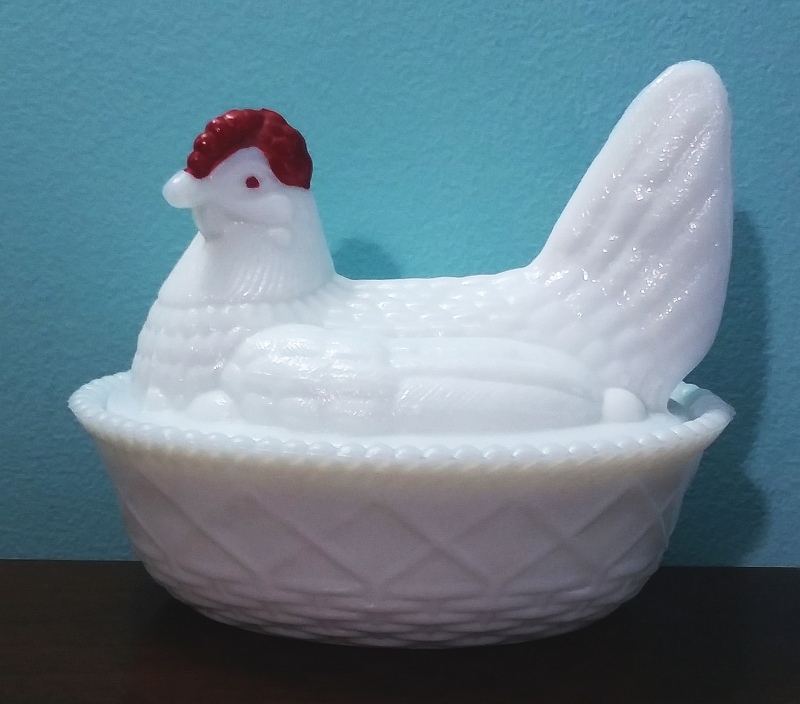
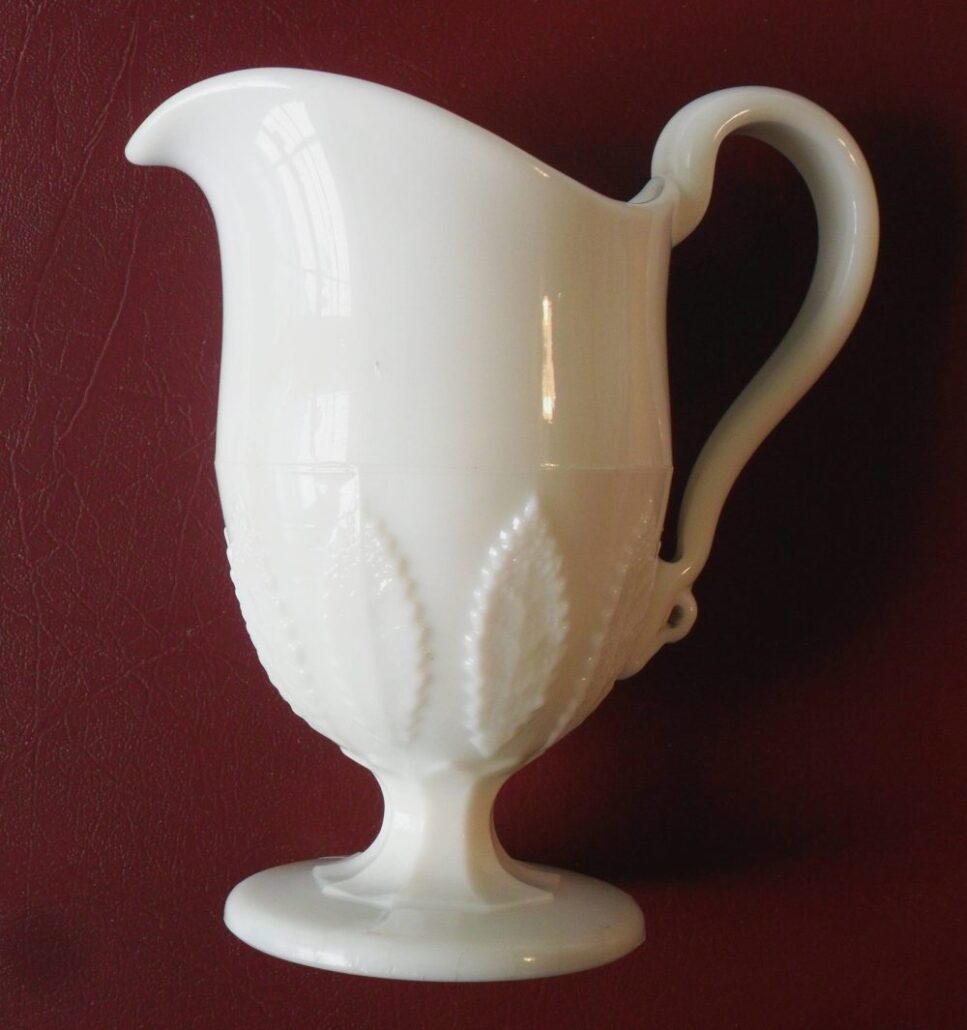
ADVERTISEMENT
COLORS
The most commonly produced color is white (thus the name “milk”) although many other shades of color have been made, including blue, green, turquoise, yellow, “custard”, beige, pink, amethyst (purple), lavender, butterscotch, maroon or mauve and a true jet black. Milk glass with a moderate amount of translucency has been termed “clambroth”, “opalescent” or “alabaster” by some collectors. Some milk glass appears as an “off-white” color, such as extremely pale blue, or a very pale pink. Some shades of light to medium green milk glass have been termed “Jade”, “Jadite” (or Jadeite), the latter being a brand name but now sometimes considered to be a “generic” name for that type of glass.
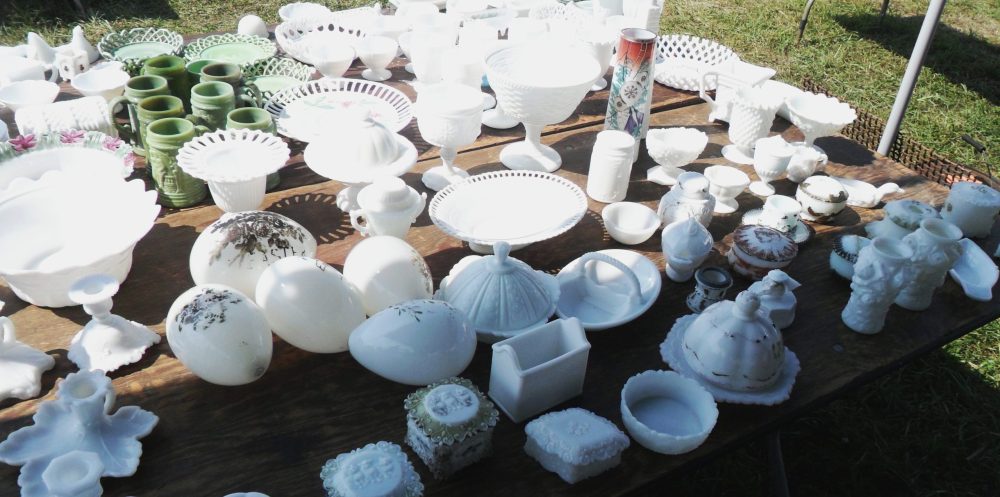
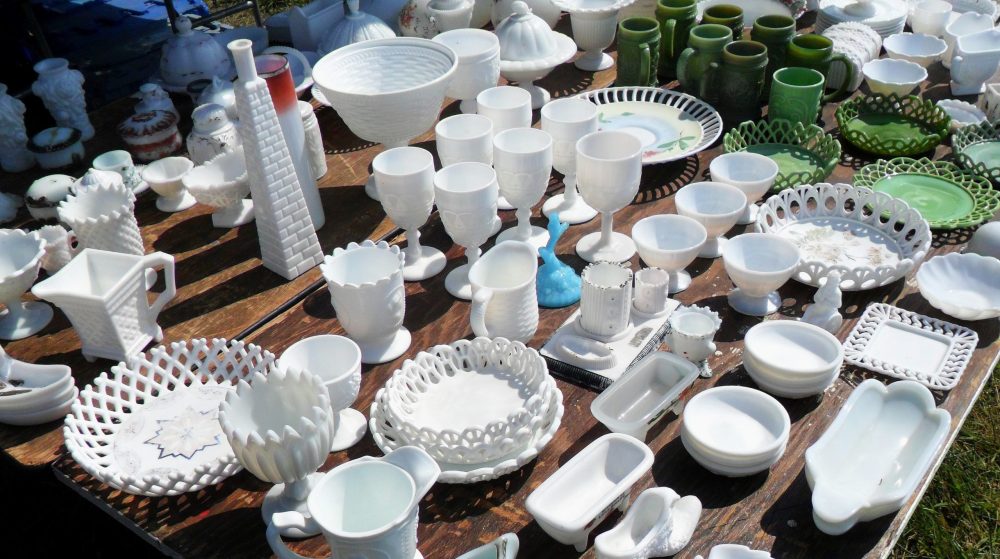
BRIEF HISTORY
Milk glass is believed to have been made at least as early as the 1500s in Venice, Italy. This type of glass was originally introduced as a lower-cost alternative to porcelain, which was highly prized and being imported to Europe from China.
Milk glass has gone through several periods of renewed popularity over the years. Opaque glass was being produced in the United States as early as the 1850s, but there is relatively little information available on companies that were producing it during that era. Boston & Sandwich Glass Company, of Sandwich, Massachusetts (1825-1888) was making opaque glass, such as candlesticks and lamps, in a variety of colors by the 1850s and possibly much earlier.
The high point in popularity of milk glass was probably the late 1880s and 1890s, and into the first few years of the 20th century. Milk glass in that time period was made into a wide variety of tableware forms/shapes including “lacy edge”, “lattice edge” or “open border” decorative plates (see photo on this page of a selection), oil lamps, goblets, mugs, milk pitchers, creamers, sugar bowls and spooners (spoonholders).
Other items included salt, pepper and sugar shakers, syrup pitchers (often called “molasses cans”), candlesticks, compotes, cake plates, serving bowls, toothpick holders, vases, covered dishes, perfume bottles, dresser sets, knickknack trays, hand blown darning eggs/nesting eggs, and much more including a variety of minor “novelty” and “whimsey” items.
A number of named patterns during the late Victorian era were made in Milk Glass, and some of these patterns are sought by collectors of EAPG (Early American Pattern Glass). For more information on EAPG, please see my webpage at this URL: EAPG (Early American Pattern Glass).
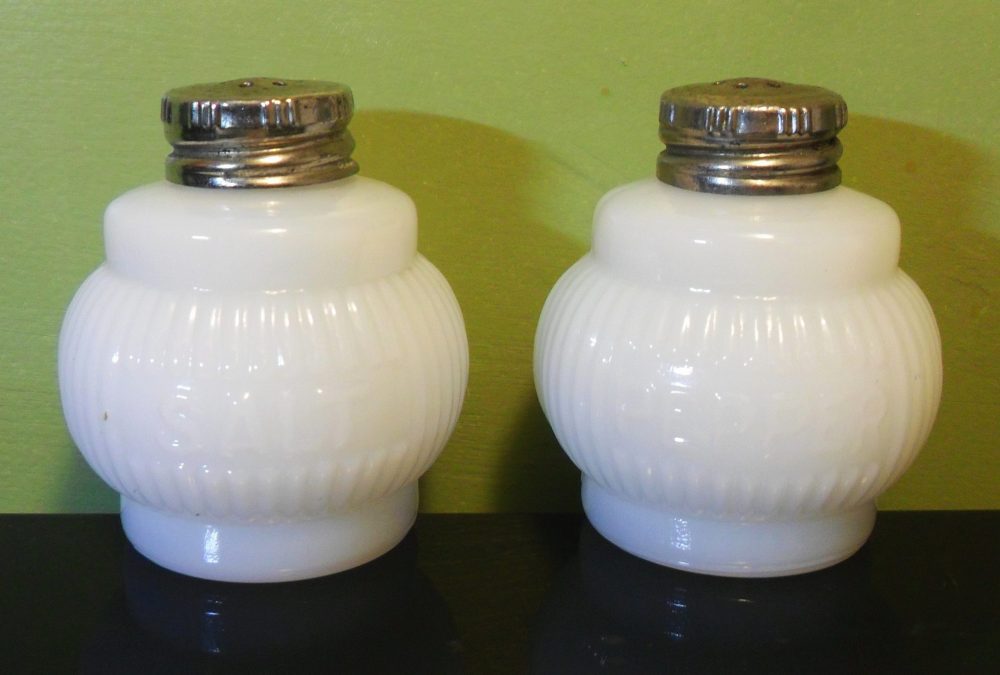
FORMULAS
Milk glass is most often made with tin dioxide as the “opacifier” along with arsenic and other ingredients, but there have been many other elements or compounds used as opacifiers, such as titanium oxide, zirconium oxide, fluorspar, cryolite, antimony, sulfates, chorides, etc. There are quite a number of different formulas or recipes that have been used over the years, including those using bone ash (calcium oxide and phosphorus pentoxide) in the glass “batch”.
The various processes that are known by which a glass can be made opaque are complicated, (and far beyond the scope of this article)! And the final appearance of a particular glass can vary depending on not only the proportions of the ingredients used in the glass formula, but also other circumstances at the time the glass is being made, such as the temperature reached of the batch before it is cooled, the length of time during which the temperature of the batch is being lowered until it begins turning into a solid, the humidity of the atmosphere in the factory where the glass is being made, and other, what might seem to be “minor issues”. The actual opaqueness may be caused, in some glasses, by microscopic crystals being formed in the glass as it cools, thus the molten material may be entirely transparent when hottest, becoming increasingly opaque as it cools and hardens. In other glasses the opacity may be already apparent while the glass is still molten.
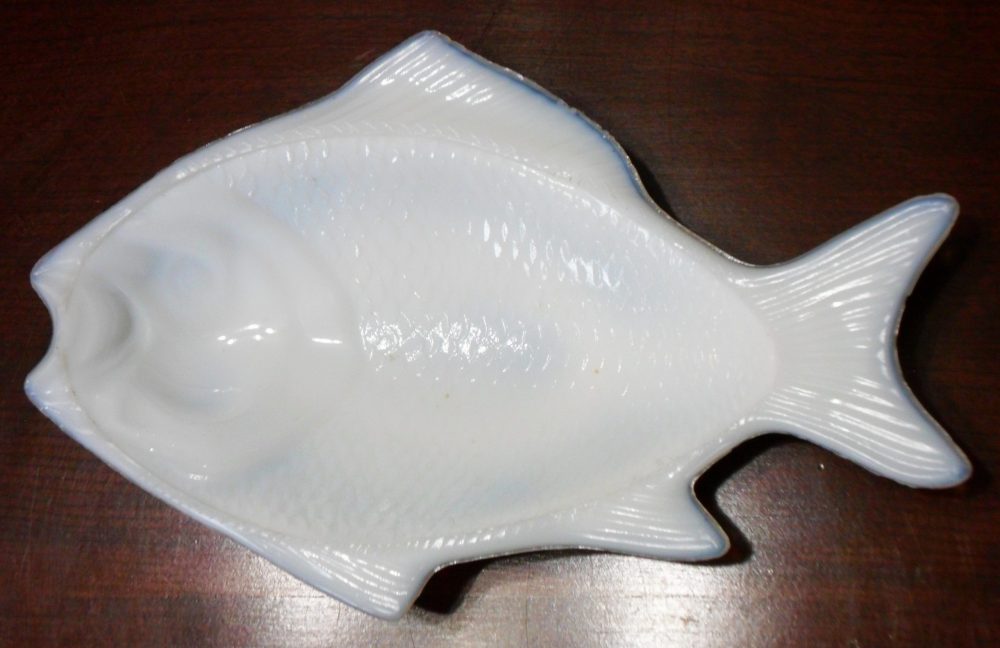
During the late 1800s there were a number of glass companies that specialized in making milk glass, which was called “Opal”, “Opaline” glass or “Opal Ware” within the glass industry during that time period. Author and glass researcher Ruth Webb Lee, in her classic books on early American pattern glass, preferred to use the term “Milk White” and urged others to do so, but that moniker never caught on with the collecting public.
ADVERTISEMENT
Atterbury & Company, of Pittsburgh, Pennsylvania, and Challinor, Taylor & Company, of Tarentum, Pennsylvania, are probably the best known for producing very large quantities of opaque glass in the late Victorian period, including white and many other colors. They produced many different patterns and shapes.
Among a number of other companies making milk glass in the late 1800s, we could include here some of the better-known including McKee & Bros (later, McKee Glass Company), Pittsburgh and Jeannette, PA; Dithridge & Company, Pittsburgh; Eagle Glass & Manufacturing Company, Wellsburg, West Virginia; Gillinder & Sons, Philadelphia, and Central Glass Company of Wheeling, West Virginia.
There were dozens of other glass companies in the United States that also produced at least some milk glass during this time period. Opaque glass was also very popular in England, one company in particular being Sowerby Glass. A glass company in France, Vallerysthal, also produced large quantities of milk glass including a beautiful opaque blue. Much of their glass was marked, and is avidly sought by collectors.
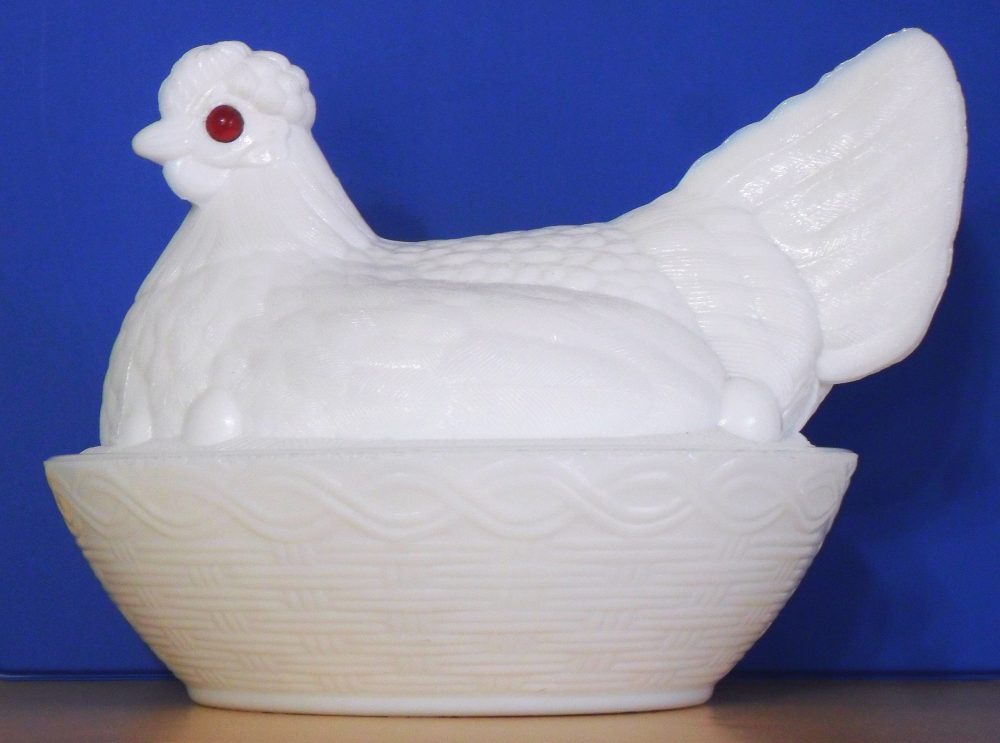
Although milk glass never “went away”, it has gone through cycles of renewed popularity throughout most of the 20th century, with the glass being made in many tableware patterns, much of it very good quality, by such glass firms as Westmoreland, Fenton, Imperial, L. E. Smith, Kemple, Jeannette, Indiana Glass, Anchor Hocking, and Hazel-Atlas. Westmoreland, Fenton, and Imperial might be considered as the “Big three” companies in modern milk glass production, as much of the newer ware seen for sale is likely to be a product of one of those makers.
One of the best-known patterns seen in milk glass is “Paneled Grape”, introduced in 1940 by Westmoreland Glass Company who made it in a huge variety of pieces over many years. Fenton Art Glass Company produced it’s popular “Hobnail” pattern in many shapes over a very long period of time throughout the mid and late 20th century. Although their Hobnail pattern was introduced in 1939, hobnail pieces in white opaque glass are said to have been introduced several years later, in about 1950.
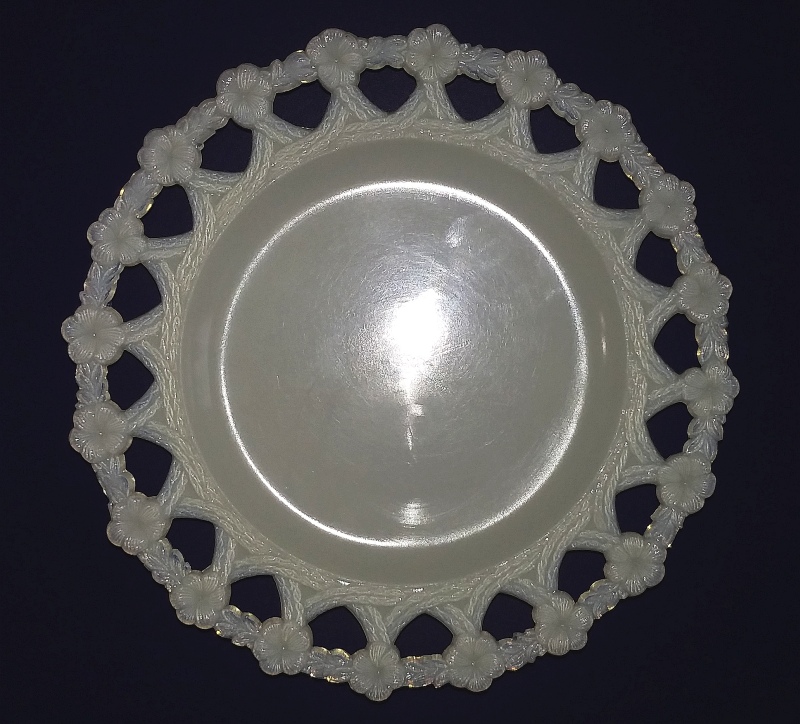
Milk glass has also been used for many products including large globes for gas station pumps, and signs on which darker lettering or designs were placed, as for advertising.
Huge numbers of “Boyd liners” were made (small discs reminiscent of miniature saucers) to be placed under the zinc lids of “Mason” or screw-lid type jars, to prevent the lids from coming into direct contact with the food inside the jars. Eagle Glass and Hazel Atlas Glass Company are two known makers of these inserts, and there were probably a number of other companies that made them as well.
Opaque glass has also been made into toy marbles, and the variety of colors and color combinations known in the field of collectible marbles is astounding. This is a huge, specialized subject which I can’t even begin to tackle!
“Slag glass” or “Marble glass” (sometimes called “Mosaic” in the late 1800s) was popular in the 1880s and consisted of 2 or more opaque colors, such as purple and white, or brown and white, being swirled together to create a “marbled” look. Challinor, Taylor & Company of Pittsburgh is believed to have made more of this type of ware than any other glass company. More recently, so-called slag glass has been produced by several companies in the latter half of the 20th century.
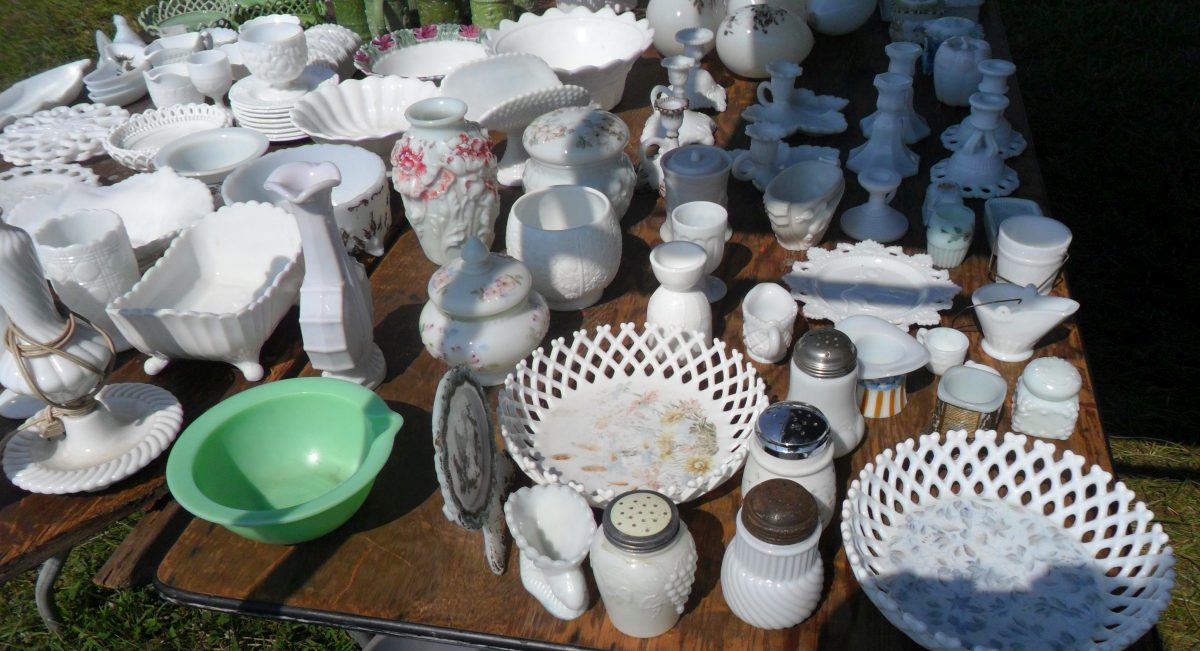
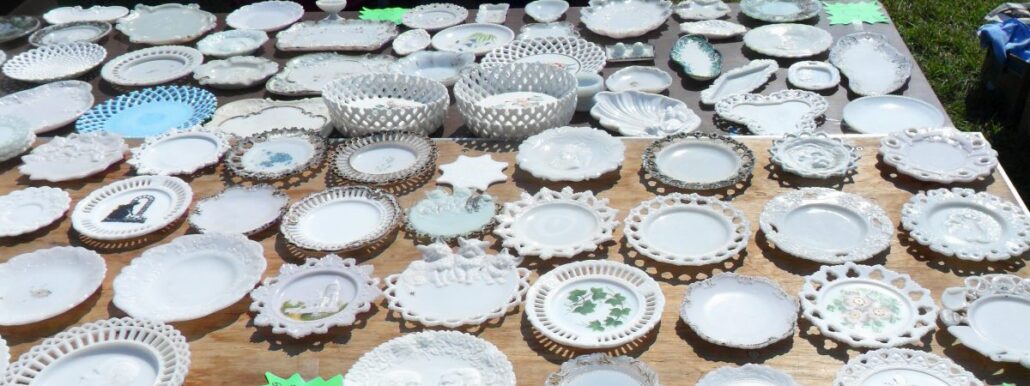
Some glass collectors over the last few decades have, whether it’s been admitted or not, looked at milk glass with some degree of disdain, and this is probably because some of the most inexpensively-made milk glass, such as vases and bowls made for the floral industry, has been produced in extremely large quantities, and eventually a good percentage of this ware has ended up for sale at thrift and consignment shops, flea markets and garage sales, selling for very little. Thus, this glass has a perception by some, whether deserved of not, of being rather “cheap”, “ho hum” or “not in demand” simply because of being so plentiful.
In my own opinion, all milk glass has some value, collectability, and interest, even the most common types of florist containers that may be seen at flea markets and similar venues. An example of this glass would be ware marked with “E. O. BRODY CO” on the base.
Many collectors of milk glass today have little familiarity with the much older, highly collectible glass from the Victorian era, which often goes unrecognized and sometimes is mixed in with much more recent milk glass.
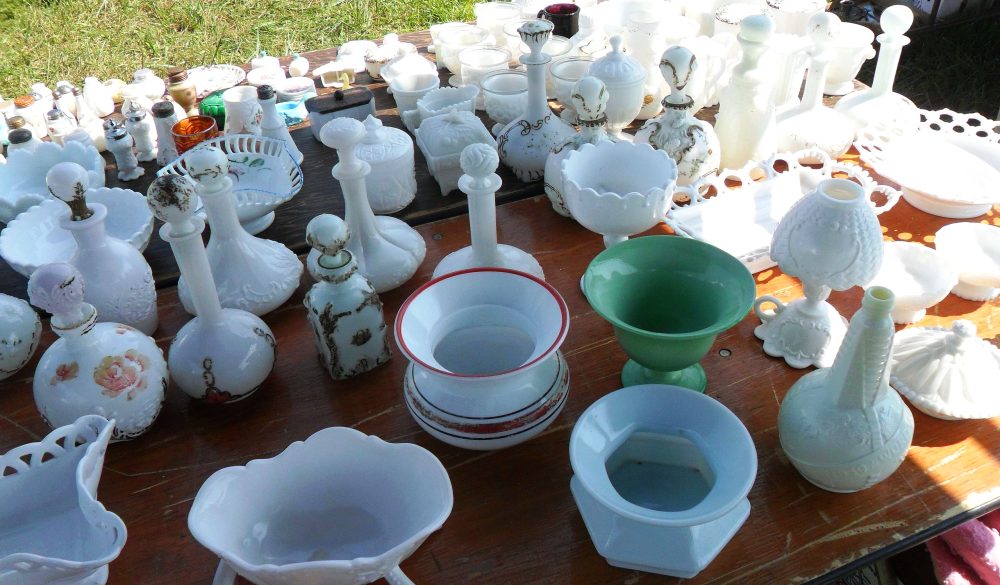
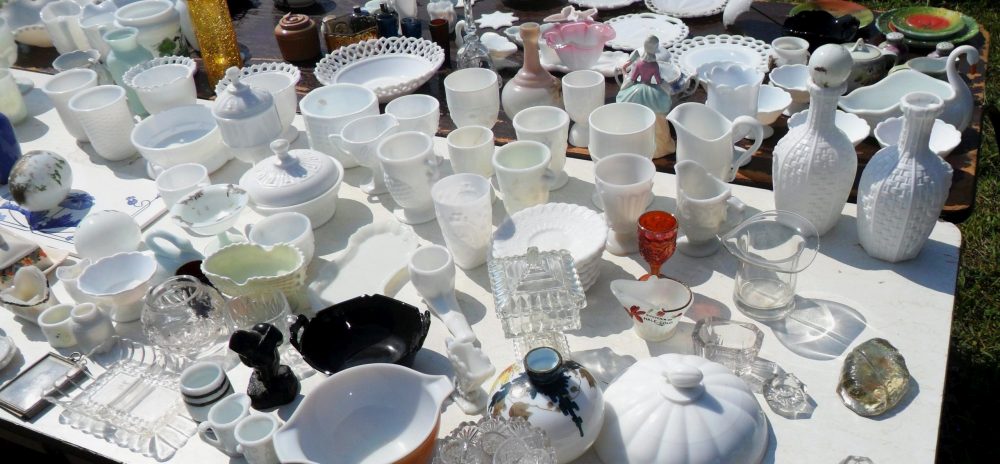
Milk glass has also been used for packaging commercial products. Especially during the 1910s-1950s huge quantities of containers were made of white milk glass, including cold cream jars, salve jars, bottles and jars for cosmetics, hair products, and medicines of various types as well as other products. As diggers of old and forgotten dumpsites can attest, lots of these containers were discarded and are frequently found when searching for bottles, pottery and other artifacts. For some photos showing some of these types of containers, please click here for a page on antique and vintage milk glass cold cream jars and salve containers.
INSULATORS
A few styles of glass electrical insulators have been made in opaque glass, including the units marked “MAYDWELL – 20 / U.S.A.” on the skirt area. These were manufactured by Crystallite Products, of Glendale, California during the 1935-1940 period. They are the best known examples of an insulator style found in milk glass. Some pieces have a faint greenish, gray or bluish cast to the glass. The type is classed as a “CD 164” in the “Consolidated Design” identification system used by glass insulator collectors.
The “beehive” (CD 145) type used on telegraph lines made by Hemingray Glass Company (marked “H.G.CO. / PETTICOAT” on the skirt), dating from the 1880s-1890s era, which has been found in dozens of color shades, is known in a beautiful opaque white milk glass, but only one example is known to exist, that piece having been found at the bottom of a bucket of common insulators many years ago. (That insulator might have been made around the same time Hemingray was producing their hand-painted “Pressed Octagon” pattern milk glass syrup pitchers). A few examples of their “HEMINGRAY-42” style are known in a poor-quality, off-white milk glass or opalescent, and were probably factory rejects.
At the bottom of this page I list a number of good books on milk glass, and some of these books illustrate a lot of the “classic” opaque glass from companies operating during the late Victorian era, glass that may not be seen very often in antique malls or even on internet sites such as ebay.
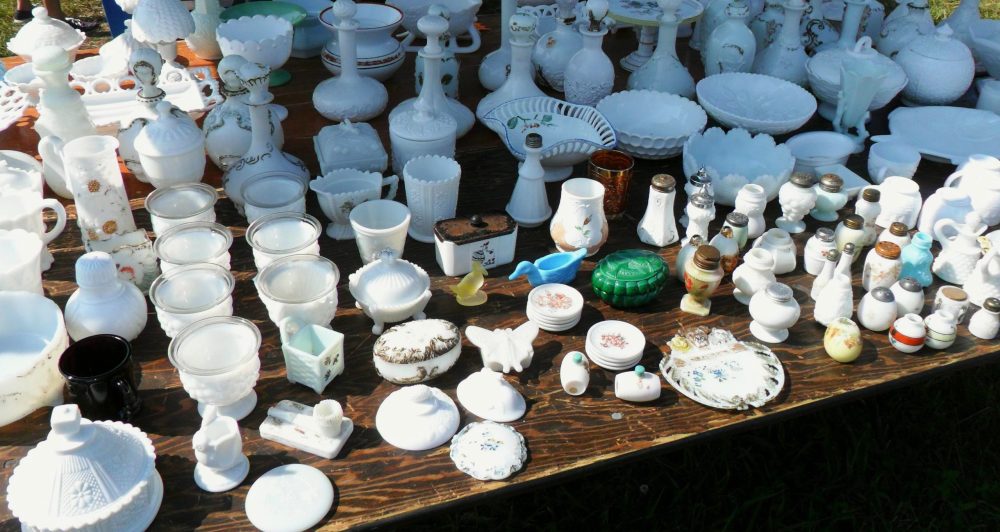
I might mention here also that there are now several discussion groups devoted to collecting and studying opaque glass on Facebook. Anyone interested in learning more about milk glass might try joining one of those groups. Also, a number of videos about collecting milk glass have recently been uploaded to YouTube by collectors.
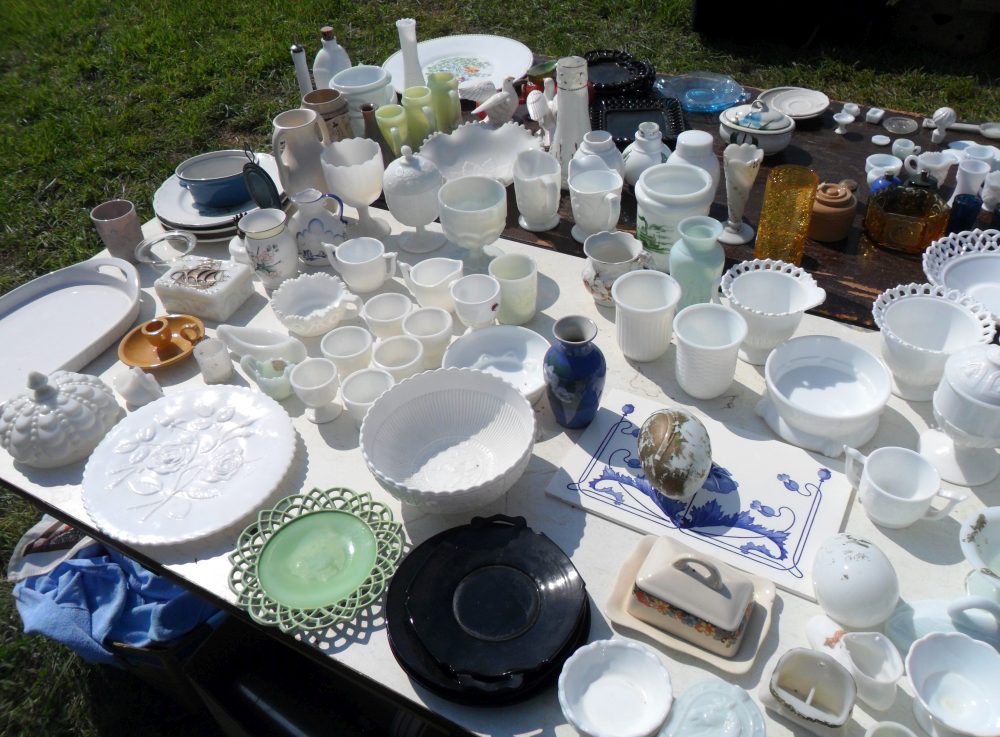
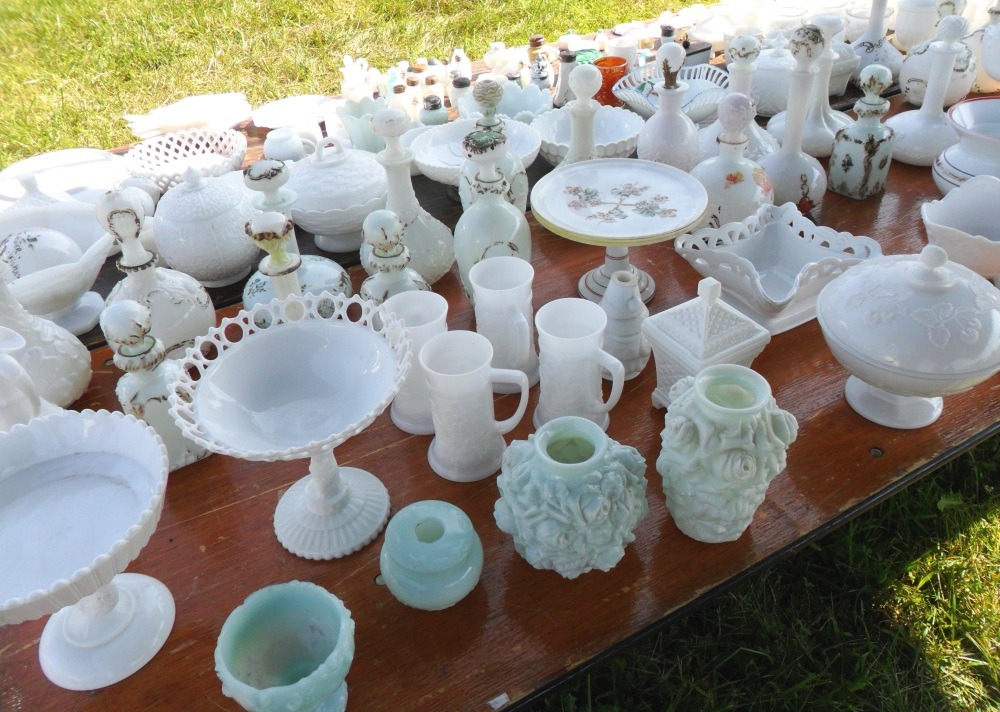
Some other pages on my site that contain at least some information relating to milk glass:
Boyd’s glass liners for mason jar lids
Atterbury & Company, Pittsburgh
Indiana Glass Company “Hen on Nest” dishes
Here are some external links to other websites about milk glass:
Collectorsweekly.com webpage on Milk Glass
National Milk Glass Collectors Society
Wikipedia page about Milk Glass
CarnivalHeaven.com -site with lots of information about Carnival glass and Indiana Glass Company – this link points to a page that discusses the popular and frequently encountered “COLONY HARVEST” tableware pattern made in milk glass by Indiana Glass Company in the 1950s and 1960s.
Books
All of the following reference books have good background information and photographs. The first three books listed are especially valuable for picturing many of the older, Victorian-era milk glass pieces that are getting harder to find, and for which a collector could be on the lookout when searching for glass. I might also mention that in some of the books listed below, prices (or “values”) are included, but these may or may not have much relevance to current-day market trends. They can be useful for giving a vague ballpark estimate on the comparative rarity of some pieces, but don’t take prices too seriously. I have seen some prices that seemed to be unrealistically high.
- Opaque Glass (Samuel Thomas Millard) 1941
Lots of black and white photos; Hundreds of pieces are pictured. Highly recommended book! This has long been out of print, but copies can be obtained inexpensively on the internet through such venues as bookfinder.com. - Milk Glass (E. M. Belknap) 1949
Unofficially considered to be the best early book on Milk / Opaque Glass, with lots of good photographs. This book is still used by many glass collectors, even 70+ years after it’s original publication. - Yesterday’s Milk Glass Today (Regis F. Ferson & Mary F. Ferson) 1981
Another very good reference book with a wide range of glass pictured, including both black & white and color photos. - Collectors’ Encyclopedia of Milk Glass (Betty and Bill Newbound) 1994
This book shows lots of milk glass, both old and relatively recent production. Gobs of full color photographs! - The Milk Glass Book (Frank Chiarenza & James Slater) 1998 This hardback, high quality volume illustrates and describes a large number of hard to find, scarce and extremely rare pieces, most never before shown in previous books about milk glass. Many of the pieces shown are listed as “Maker Unknown” but the authors have done a good job in providing any available information that had been uncovered up to the time the book was published. Many early examples of opaque glass are included, as well as some items that have been made fairly recently. A nice selection of older candlesticks, covered animal dishes, figurals, bottles, and many other beautifully designed and executed pieces are pictured. HIGHLY recommended book to help round out your library on milk glass!
- Early Milk Glass 1891-1911 – Monograph Number 15 (Tom Felt, West Virginia Museum of American Glass) 2001 One of an extensive series of monographs about glass and glassware, published by the West Virginia Museum of American Glass over the past several years. (Many of them are available on ebay and the museum website.) In this study, many advertisements featuring opal ware from glass-related trade magazines are reproduced. There is also some brief background information on the glass factories covered. Spiral bound.
- Milk Glass: Imperial Glass Corporation (Myrna Garrison & Bob Garrison) 2000 Many color photos and hundreds of B&W photos of catalog pages, showing the wide variety of opaque/milk glass produced by Imperial Glass. A very good reference book that any collector of milk glass or Imperial Glass Corporation would enjoy!
- Early American Pressed Glass (Ruth Webb Lee) 1931 and several later revisions, up to 1960 This is a classic reference book on “Early American Pattern Glass” (EAPG) and Lee concentrates primarily on clear and colored pattern glass of the late Victorian era, but she also includes a chapter as well as photographs of early milk glass pieces. I strongly recommend this book as it contains lots of detailed information on older glassware. This out-of-print book can be obtained inexpensively on some internet book sites.
- Victorian Glass (Ruth Webb Lee) 1944 Another great book from Lee. Here, she expands on her list of patterns discussed in the above mentioned book, but also includes some information on opaque glass items such as covered animal dishes, whimsies such as the glass figural hats, slippers, boots and shoes and a large number of photographs of late Victorian era vases, many made in milk glass. This book should be in the library of every “hardcore” glass collector.
- Victorian Colored Pattern Glass Book III: Syrups, Sugar Shakers & Cruets From A to Z (William Heacock) 1976 This is just one of a series of books published by glass historian/researcher William Heacock (1947-1988) in the 1970s and 1980s. This volume doesn’t specifically concentrate on milk glass but I have to mention it for the gorgeous photographs that include syrup pitchers and sugar shakers in milk glass and various opaque colors scattered throughout the book, attributed to a number of glass companies including Dithridge & Company, Pittsburgh, PA; Consolidated Lamp & Glass Company, Fostoria, OH & Coraopolis, PA, and Northwood Glass Company, Indiana, PA.
- Covered Animal Dishes (Everett Grist) 1988 Another book I recommend for the large, BEAUTIFUL full-color photographs of many opaque glass covered dishes, old and new. Downsides of this book to be aware of: It is a paperback with poor binding so pages may start to fall out after repeated handling, and there are a number of factual errors, pertaining to attribution. The National Milk Glass Collectors Society (link above on this page) has information on corrections to this book and others.
- Victorian Glass Novelties (Jo and Bob Sanford) 2003 This volume covers a large number of novelties and “whimsey” items of all types, in many colors, made during the era of Early American Pattern Glass (EAPG) which includes quite a nice selection of hard-to-find and seldom seen pieces made in milk glass. Hardcover book with beautiful photography.
- Pattern Glass Mugs (John B. Mordock & Walter L. Adams) 1995 This is one of my favorite books on EAPG, and the unofficial “glass mug bible” used by collectors of EAPG mugs. Although most listings are of clear and transparent colored mugs, there are a number of opaque glass mugs listed and pictured, including pieces made by Atterbury & Co, McKee & Bros, as well as some by unidentified makers. A few milk glass mugs shown are believed to be from England or France.
ADVERTISEMENT

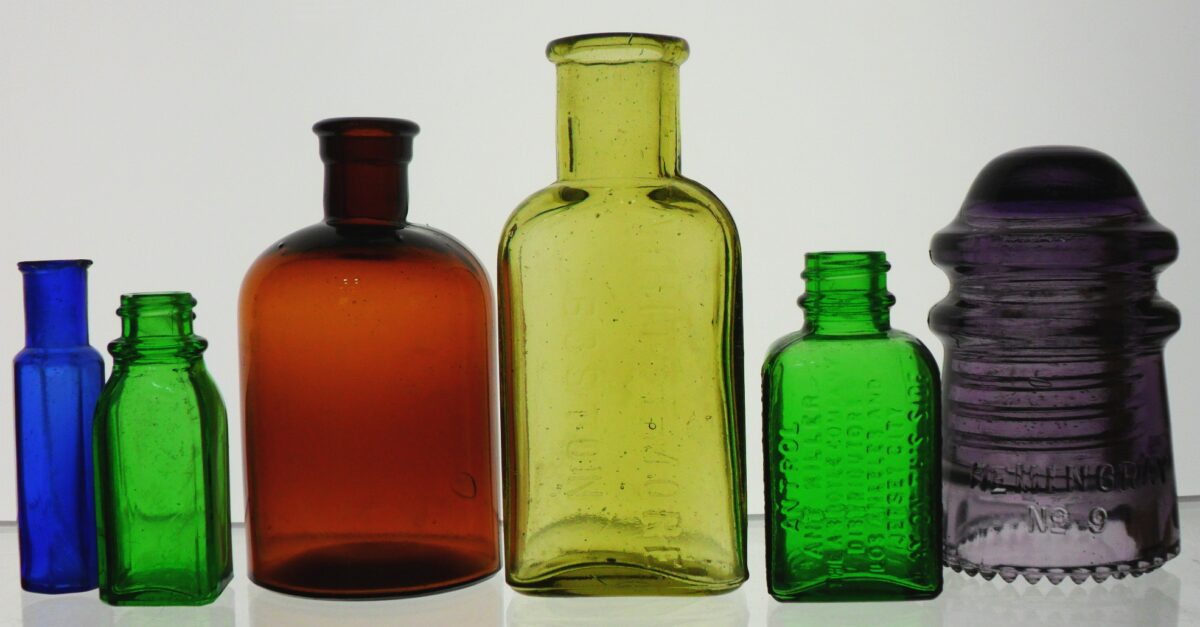
Just THANK YOU FOR SHARING THE HARD WON INFO!!!!
You have the most amazing web-site on glass that I have ever seen. The work involved in putting together this comprehensive site boggles my mind. Well done! and thank you!
Hi Peggy,
Thank you very much for your kind words about the site! And please keep my site bookmarked and check it out again! I appreciate the input.
The very best to you and yours!
~David